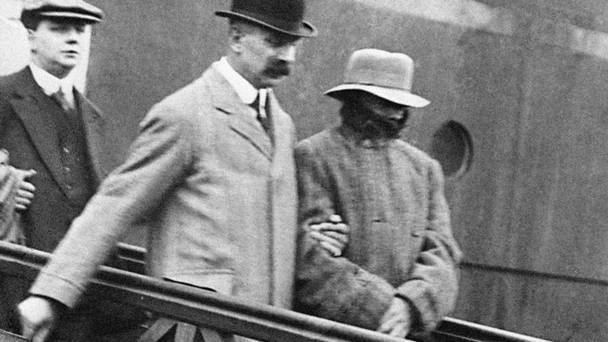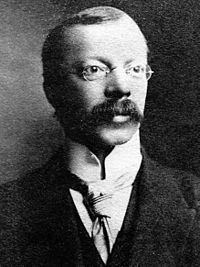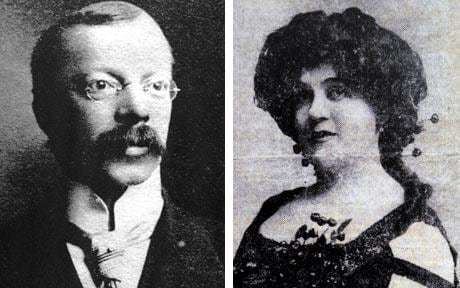Nationality American Name Hawley Crippen | Occupation Homeopath Education University of Michigan Date apprehended July 31, 1910 | |
 | ||
Victims Cora Henrietta Crippen nee Turner Died November 23, 1910, HM Prison Pentonville, London, United Kingdom | ||
Criminal penalty Death by hanging Criminal status Capital punishment | ||
Scotland yard s greatest investigations dr crippen history channel 1996
Hawley Harvey Crippen (September 11, 1862 – November 23, 1910), usually known as Dr Crippen, was an American homeopath, ear and eye specialist and medicine dispenser. He was hanged in Pentonville Prison in London for the murder of his wife Cora Henrietta Crippen, and was the first suspect to be captured with the aid of wireless telegraphy.
Contents
- Scotland yard s greatest investigations dr crippen history channel 1996
- Dr hawley harvey crippen scrapbook
- Early life and career
- Murder and aftermath
- Transatlantic arrest
- Trial and execution
- Possible motives for the murder
- Doubts regarding the verdict
- Controversial new evidence
- Media adaptations
- Curiosities
- References

In 2007, DNA evidence questioned the identification of the body found in Crippen's cellar that was supposed to be Crippen's wife. This evidence suggested that the remains discovered in his cellar were, in fact, those of a male person. These conclusions are disputed.
Dr hawley harvey crippen scrapbook
Early life and career

Crippen was born in Coldwater, Michigan, to Andresse Skinner (died 1909) and Myron Augustus Crippen (1827–1910), a merchant. Crippen studied first at the University of Michigan Homeopathic Medical School and graduated from the Cleveland Homeopathic Medical College in 1884. Crippen's first wife, Charlotte, died of a stroke in 1892, and Crippen entrusted his parents, living in California, with the care of his two-year-old son, Hawley Otto.
Having qualified as a homeopath, Crippen started to practise in New York, where in 1894 he married his second wife, Corrine "Cora" Turner (stage name: Belle Elmore), born Kunigunde Mackamotski to a German mother and a Polish-Russian father. She was a would-be music hall singer who openly had affairs. In 1894 Crippen started working for Dr Munyon's, a homeopathic pharmaceutical company. In 1897, Crippen and his wife moved to England, although his US medical qualifications were not sufficient to allow him to practise as a doctor in the UK. As Crippen continued working as a distributor of patent medicines, Cora socialised with a number of variety players of the time, including Lil Hawthorne of The Hawthorne Sisters and Lil's husband/manager John Nash.
Crippen was sacked by Munyon's in 1899 for spending too much time managing his wife's stage career. He became manager of Drouet's Institution for the Deaf, where he met Ethel Le Neve, a young typist, around 1903. After living at various addresses in London, the Crippens finally moved in 1905 to 39 Hilldrop Crescent, Camden Road, Holloway, London, where they took in lodgers to augment Crippen's meagre income. Cora cuckolded Crippen with one of these lodgers, and in turn Crippen took Le Neve as his mistress in 1908.
Murder and aftermath
After a party at their home on January 31, 1910, Cora disappeared. Hawley Crippen claimed that she had returned to the United States, and later added that she had died, and had been cremated, in California. Meanwhile, his lover, Ethel "Le Neve" Neave, moved into Hilldrop Crescent and began openly wearing Cora's clothes and jewelry.
Police first heard of Cora's disappearance from her friend, strongwoman Kate Williams, better known as Vulcana, but began to take the matter more seriously when asked to investigate by a personal friend of Scotland Yard Superintendent Frank Froest, John Nash and his entertainer wife, Lil Hawthorne. The house was searched, but nothing was found, and Crippen was interviewed by Chief Inspector Walter Dew. Crippen admitted that he had fabricated the story about his wife having died and explained that he had made it up in order to avoid any personal embarrassment because she had in fact left him and fled to America with one of her lovers, a music hall actor named Bruce Miller. After the interview (and a quick search of the house), Dew was satisfied with Crippen's story. However, Crippen and Le Neve did not know this and fled in panic to Brussels, where they spent the night at a hotel. The following day, they went to Antwerp and boarded the Canadian Pacific liner SS Montrose for Canada.
Transatlantic arrest
Their disappearance led the police at Scotland Yard to perform another three searches of the house. During the fourth and final search, they found the torso of a human body, buried under the brick floor of the basement. Pathologist Bernard Spilsbury found traces of the calming drug scopolamine. The corpse was identified by a piece of skin from its abdomen; the head, limbs, and skeleton were never recovered.
Meanwhile, Crippen and Le Neve were crossing the Atlantic on Montrose, with Le Neve disguised as a boy. Captain Henry George Kendall recognized the fugitives and, just before steaming beyond the range of his ship-board transmitter, had telegraphist Lawrence Ernest Hughes send a wireless telegram to the British authorities: "Have strong suspicions that Crippen London cellar murderer and accomplice are among saloon passengers. Mustache taken off growing beard. Accomplice dressed as boy. Manner and build undoubtedly a girl." Had Crippen travelled third class, he probably would have escaped Kendall's notice. Dew boarded a faster White Star liner, SS Laurentic, from Liverpool and arrived in Quebec, Canada, ahead of Crippen, and contacted the Canadian authorities.
As Montrose entered the St. Lawrence River, Dew came aboard disguised as a pilot. Canada was then still a dominion within the British Empire. If Crippen, an American citizen, had sailed to the United States instead, even if he had been recognised, it would have taken extradition proceedings to bring him to trial. Kendall invited Crippen to meet the pilots as they came aboard. Dew removed his pilot's cap and said, "Good morning, Dr Crippen. Do you know me? I'm Chief Inspector Dew from Scotland Yard." After a pause, Crippen replied, "Thank God it's over. The suspense has been too great. I couldn't stand it any longer." He then held out his wrists for the handcuffs. Crippen and Le Neve were arrested on board the Montrose on July 31, 1910. Crippen was returned to England on board the SS Megantic.
The Crippen murder was featured in a popular song:
Trial and execution
Crippen and le Neve were tried separately at the London assizes, held at the Central Criminal Court, Old Bailey, London; Crippen's trial took place from 18 to 22 October and Ethel le Neve's on 25 October 1910.
The pathologists appearing for the prosecution, including Spilsbury, could not identify the remains or even discern whether they were male or female. However, Spilsbury found a piece of skin with what he claimed to be an abdominal scar consistent with Cora's medical history. Large quantities of the toxic compound hyoscine were found in the remains, and Crippen had bought the drug before the murder from a local chemist.
Crippen's defence maintained that Cora had fled to America with another man named Bruce Miller and that Cora and Hawley had been living at the house since only 1905, suggesting a previous owner of the house was responsible for the placement of the remains. The defence asserted that the abdominal scar identified by pathologist Spilsbury was really just folded tissue, for among other things, it had hair follicles growing from it, something scar tissue could not have; Spilsbury noted that the sebaceous glands appeared at the ends but not in the middle of the scar.
Other evidence presented by the prosecution included a piece of a man's pyjama top supposedly from a pair Cora had given Crippen a year earlier. The pyjama bottoms were found in Crippen's bedroom, but not the top. The fragment included the manufacturer's label Jones Bros. Curlers with bleached hair consistent with Cora's were found with the remains. Testimony from a Jones Bros. representative, the store that the pyjama top fragment came from, stated that the product was not sold prior to 1908, thus placing the date of manufacture well within the time period of when the Crippens occupied the house and when Cora gave the garment to Hawley the year before in 1909.
Throughout the proceedings and at his sentencing, Crippen showed no remorse for his wife and concern for only his lover's reputation. After just 27 minutes of deliberations, the jury found Crippen guilty of murder. He was hanged by John Ellis, assisted by William Willis, at 9 a.m. on November 23, 1910 at Pentonville Prison, London.
Le Neve was charged only with being an accessory after the fact and acquitted. She emigrated to the United States on the morning of her lover's execution. At his request, her photograph was placed in his coffin and buried with him.
Although Crippen's grave in the prison grounds is not marked by a stone, tradition has it that soon after his burial, a rose bush was planted over it. Some of his relatives in Michigan have begun lobbying for his remains to be repatriated to the United States.
Possible motives for the murder
A theory which was first propounded by Edward Marshall Hall was that Crippen was using hyoscine on his wife as a depressant or anaphrodisiac, but accidentally gave her an overdose and then panicked when she died. It is said that Hall declined to lead Crippen's defense because another theory was to be propounded.
In 1981, newspapers reported that Sir Hugh Rhys Rankin claimed to have met Ethel Le Neve in 1930 in Australia and that on that occasion, she told him that Crippen murdered his wife because she had syphilis.
Doubts regarding the verdict
Whether Crippen murdered his wife has been disputed.
The novelist Raymond Chandler commented that it seemed unbelievable that Crippen would successfully dispose of his wife's limbs and head, and then, rather stupidly, bury her torso under the cellar floor of his home.
Dornford Yates, a novelist who was a junior barrister at the trial, records that the remains were placed in lime so that they would be destroyed, but suggests that Crippen failed to realize that while dry quicklime destroys, if water is added, it becomes slaked lime and preserves. Yates used this fact in the plot of his novel The House That Berry Built and told the story of the trial from his viewpoint in his memoirs As Berry and I Were Saying.
Controversial new evidence
In October 2007, Michigan State University forensic scientist David Foran claimed that mitochondrial DNA evidence showed that the remains found beneath the cellar floor in Crippen's home were not those of Cora Crippen. This research was based on genealogical identification of three matrilineal relatives of Cora Crippen (great-nieces, located by U.S. genealogist Beth Wills), whose mitochondrial DNA haplotype was compared with DNA extracted from a slide with flesh taken from the torso in Crippen's cellar. This has raised new questions about the identity of the remains found in the cellar, and – by extension – over Crippen's guilt.
One theory is that Crippen may have been carrying out illegal abortions; it may be that one of his patients died and that he disposed of the body in the way he was accused of disposing of his wife. However, the remains were also tested for sex at Michigan State, using a highly sensitive assay of the Y chromosome. On this basis, the researchers found that the body parts were those of a man.
The research team also argued that a scar on the abdomen of the body, which the Crown Prosecution interpreted as a scar consistent with one Mrs. Crippen was known to have, convincing the jury that the remains were Mrs. Crippen’s, was incorrectly identified, because the tissue had hair follicles, whereas scars do not (a point which Crippen's defence argued at the time).
These recent arguments for Crippen's innocence have been disputed by some commentators. It has been argued that the DNA sample could have been tainted or mislabeled, or alternatively that the putative relatives were not actually blood relatives of Mrs. Crippen. The research has since been published in the January 2011 issue of the Journal of Forensic Sciences.
In a skeptical review of the new evidence, David Aaronovitch has written: "As to the body being male, well the American team was using a 'special technique' that is 'very new' and 'done only by this team' and working on a single, century-old slide, described by the team leader as a 'less than optimal sample'". However, Foran stated in an interview, "There was a lot more DNA work than what is portrayed in the film. Those tests showed unequivocally that the remains were male".
John Trestrail had previously requested New Scotland Yard to provide samples of the blonde hair found in curlers at the scene (and now preserved in New Scotland Yard's museum) to conduct DNA testing to see if they are Cora's. New Scotland Yard has repeatedly denied his request. However, New Scotland Yard was willing to test a hair from the crime scene for a fee, which in turn was rejected by the investigators as "over the top."
Trestrail has hypothesized that the police planted the body parts and particularly the fragment of the pyjama top at the scene to incriminate Crippen. He suggests that Scotland Yard was under tremendous public pressure to find and bring to trial a suspect for this heinous crime. An independent observer points out that the case did not become public until after the remains were found.
In December 2009 the Criminal Cases Review Commission, having reviewed the case, declared that the court of appeal will not hear the case to pardon Crippen posthumously.
Media adaptations
Curiosities
In the Museum of Automata in the Tibidabo Amusement Park in Barcelona, there is a piece that recreates the execution of Dr. Crippen. The machine dates from 1921 and is fully operational. A waxwork of Crippen can be seen in the Chamber of Horrors at Madame Tussauds in London. During the Dogger Bank earthquake of 1931 which was the strongest earthquake recorded in the United Kingdom, the head of his waxwork fell off.
